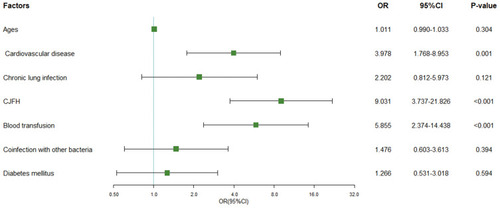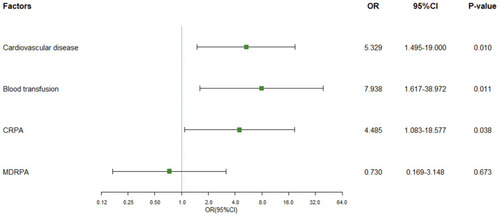Figures & data
Table 1 Demographic, Clinical Characteristics and Outcomes of 215 Patients with P. aeruginosa Bacteremiaa
Figure 1 Risk factors for mortality of 215 hospitalized patients with P. aeruginosa bacteremia in China. Cardiovascular disease (OR=3.978, P=0.001), blood transfusion (OR=5.855, P<0.001) and hospitalization in China-Japan Friendship Hospital (CJFH) (OR=9.031, P<0.001) were demonstrated to be independently associated with the mortality among all patients.

Table 2 Demographic, Clinical Characteristics and Outcomes of 69 Patients with P. aeruginosa Bacteremiaa
Figure 2 Risk factors for mortality of 69 in-hospital patients with P. aeruginosa bacteremia in China-Japan Friendship Hospital (CJFH). Cardiovascular disease (OR=5.329, P=0.010), blood transfusion (OR=7.938, P=0.011) and carbapenem-resistant P. aeruginosa (CRPA) phenotype (OR=4.485, P=0.038) were found to be associated with increased odds of death there.

Figure 3 The resistance profile of P. aeruginosa strains from 42 non-survivors in China-Japan Friendship Hospital. P. aeruginosa resistance is serious given that a total of 30 carbapenem-resistant P. aeruginosa (CRPA) strains and 29 multidrug-resistant P. aeruginosa (MDRPA) strains were found in 42 non-survivors.

Figure 4 Kaplan–Meier analysis of 5-day mortality in patients in China-Japan Friendship Hospital. (A) Kaplan-Meier analysis of 5-day mortality in patients with carbapenem-resistant P. aeruginosa (CRPA) bacteremia (N=40) and in patients with carbapenem- susceptible P. aeruginosa (CSPA) bacteremia (N=29). (B) Kaplan–Meier analysis of 5-day mortality in patients with multidrug-resistant P. aeruginosa (MDRPA) bacteremia (N=41) and without (N=28). The survival curve showed that CRPA and MDRPA phenotypes were significantly associated with 5-day mortality (P<0.05).

